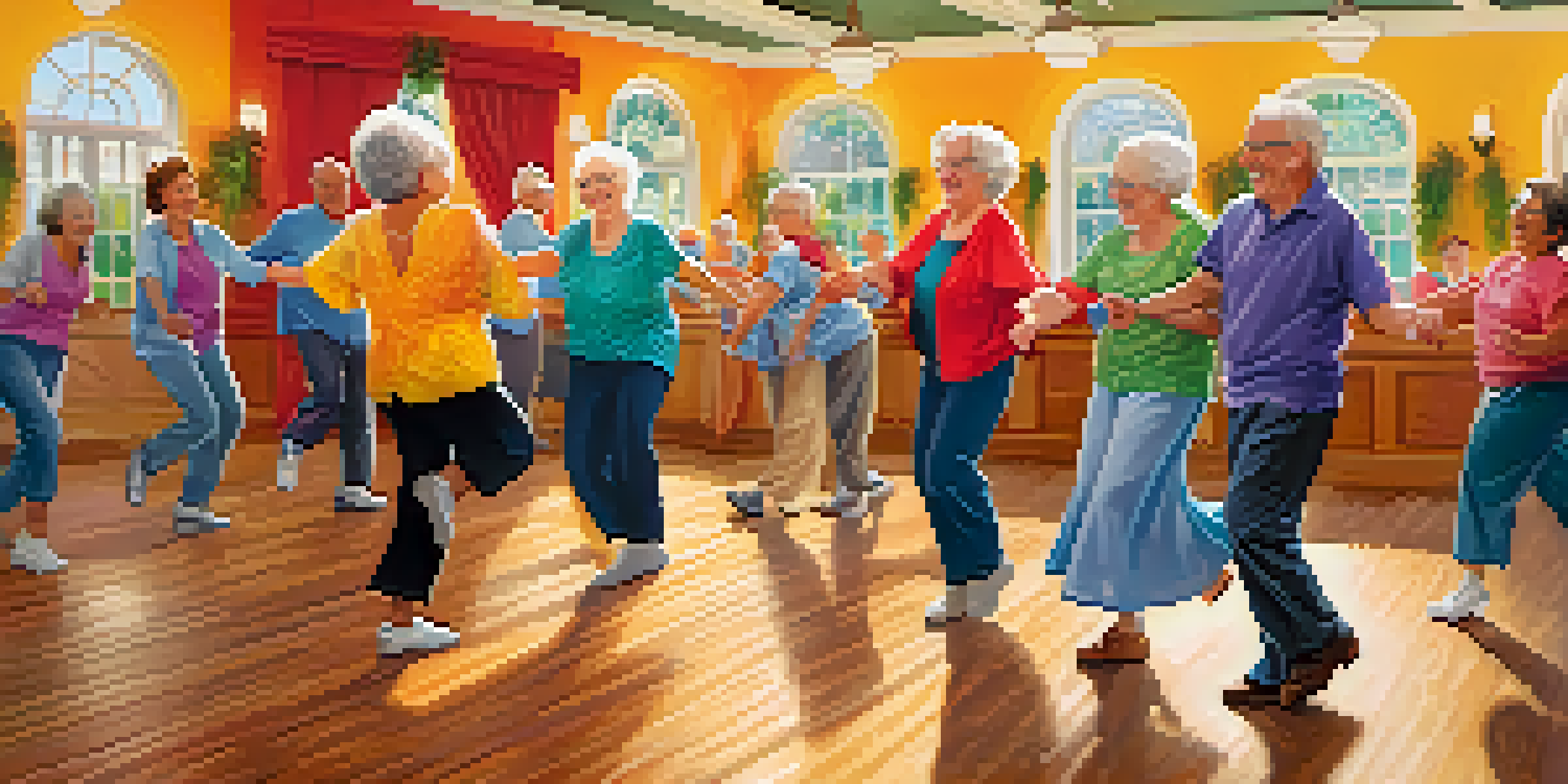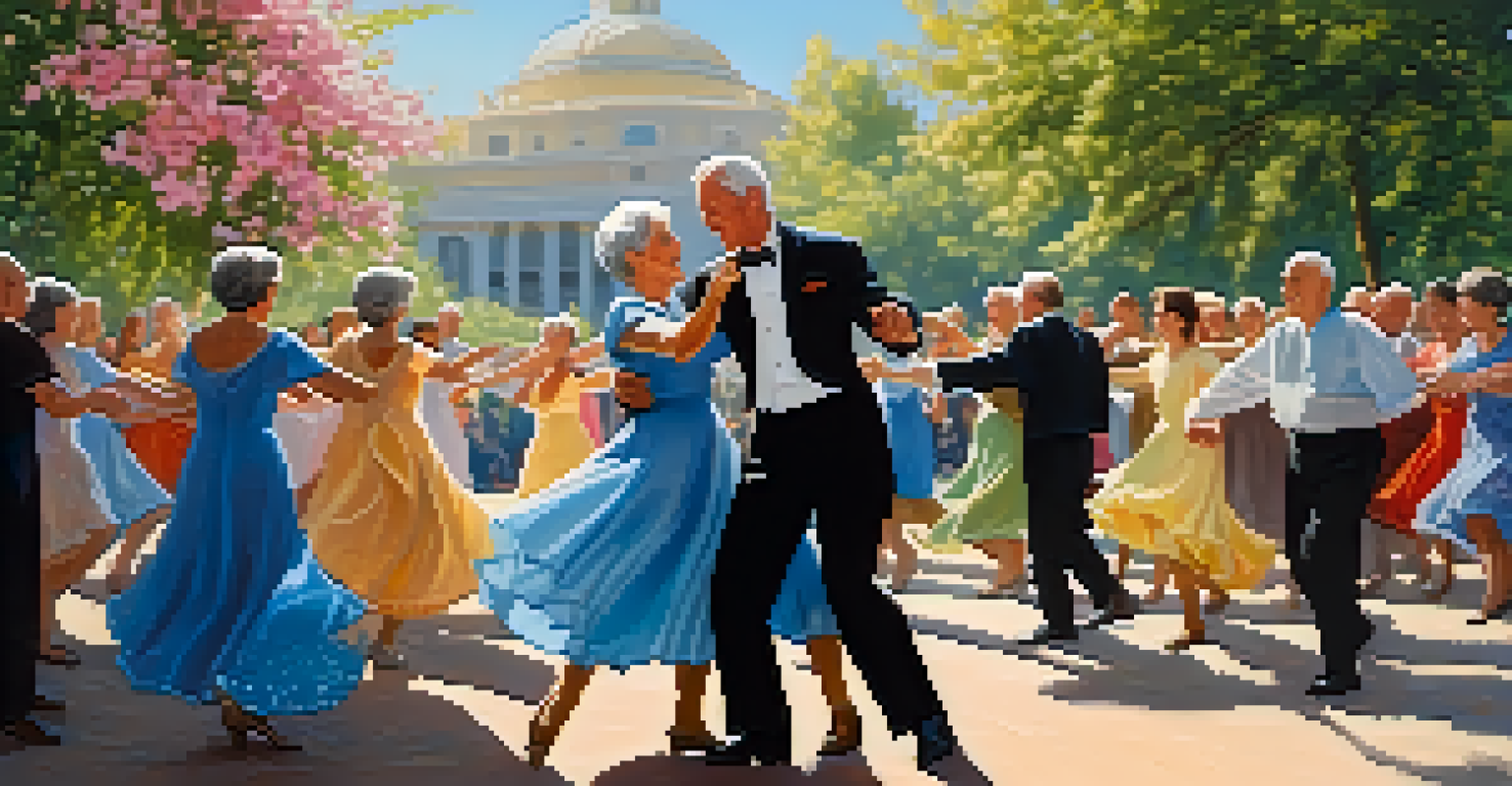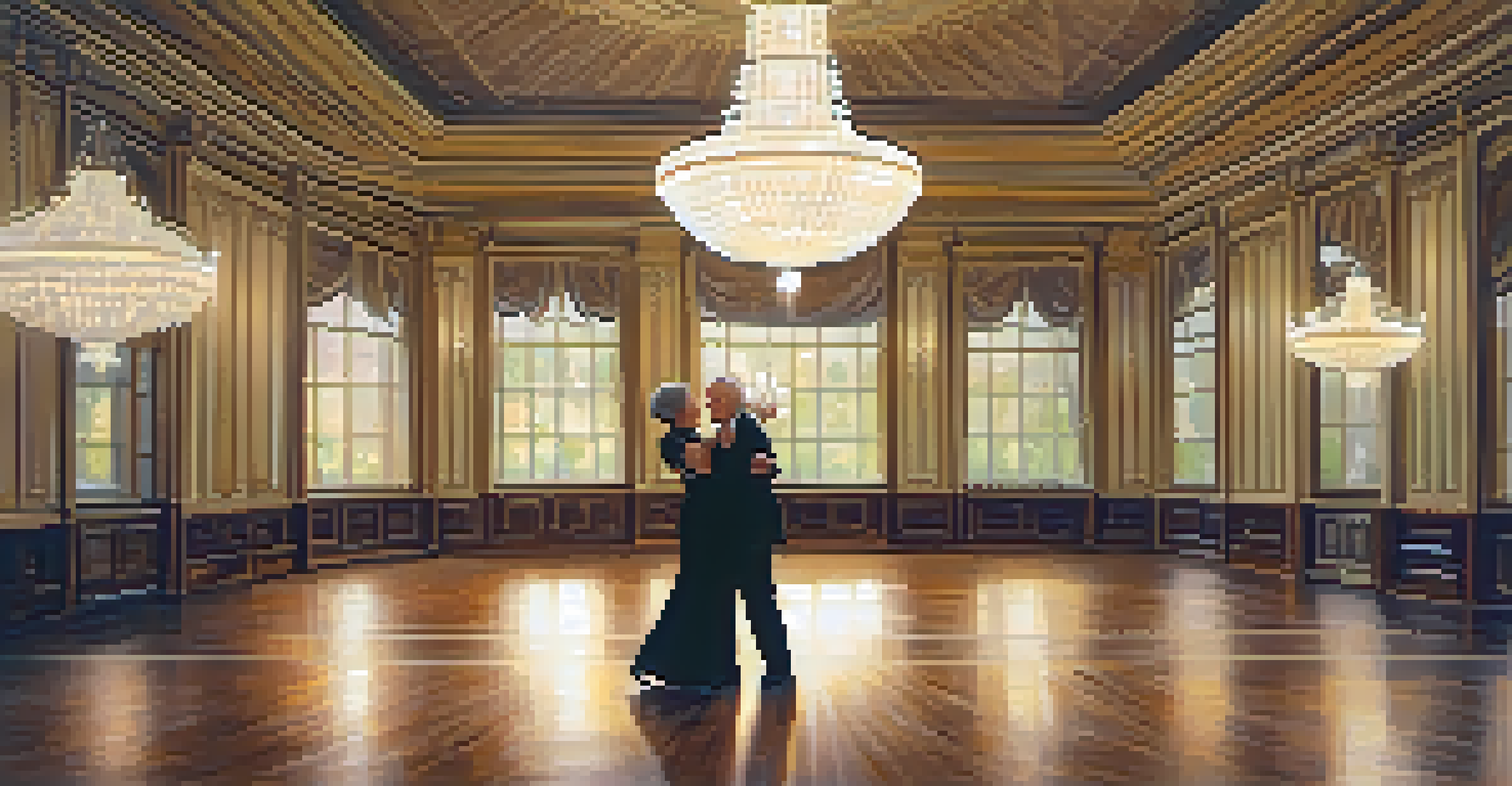Physical Benefits of Dance for Older Adults: An Overview

Dance Improves Balance and Coordination in Older Adults
One of the most significant benefits of dance for older adults is the improvement in balance and coordination. As we age, our ability to maintain balance can decline, leading to a higher risk of falls. Engaging in dance routines encourages body awareness and spatial orientation, which are essential for stability.
Dancing is like dreaming with your feet!
For instance, styles like salsa or ballroom require shifts in weight and changes in direction, honing these skills. A simple waltz can teach an older adult to pivot and glide gracefully, reinforcing their balance in a fun and social way. This, in turn, can help reduce the fear of falling, empowering older adults to move more confidently.
Moreover, dance not only strengthens the muscles involved in balance but also enhances cognitive functions related to coordination. By learning new steps and rhythms, seniors engage their minds, which complements their physical improvements. This holistic approach makes dance a delightful and effective form of exercise.
Enhancing Flexibility Through Dance Activities
Flexibility is a crucial component of overall physical health, particularly for older adults. Regular dance practice involves a variety of movements that stretch and strengthen muscles, ultimately improving flexibility. Whether it’s a gentle ballet class or a lively Zumba session, each dance style encourages the body to reach and extend.

Take a moment to consider the graceful movements of a dancer in a contemporary routine. The fluidity of their motions showcases how dance promotes range of motion in joints, which can help alleviate stiffness. This increased flexibility not only enhances performance in dance but also contributes to daily activities, making tasks like bending down or reaching up easier.
Dance Enhances Balance and Coordination
Engaging in dance routines helps older adults improve their balance and coordination, reducing the risk of falls.
Additionally, flexibility gained from dance can reduce the risk of injuries. With improved joint mobility, older adults can enjoy a more active lifestyle, whether that includes gardening or playing with grandchildren. In essence, dance becomes a joyful way to keep the body limber and agile.
Building Strength and Endurance Through Dance
Dance is a fantastic way for older adults to build both strength and endurance. Many dance forms require lifting, moving, and supporting one's own body weight, which naturally enhances muscle strength. For example, tapping feet in a swing dance can engage leg muscles, while arm movements in jazz dance can tone upper body strength.
Dance is the hidden language of the soul.
As older adults dance regularly, they not only gain muscle but also enhance their cardiovascular endurance. When participants engage in energetic dance styles, they effectively raise their heart rates, which is beneficial for heart health. Think of it as a fun workout disguised as social interaction, making the exercise feel less strenuous.
Over time, this combination of strength and endurance can lead to improved overall fitness levels. Increased strength helps with daily tasks, while better endurance allows for longer periods of activity without fatigue. In this way, dance not only energizes but also enriches life quality.
Promoting Joint Health with Regular Dance Practice
Regular dance practice can be beneficial for joint health, especially in older adults who might experience arthritis or stiffness. The gentle movements and rhythmic patterns of dance provide a low-impact way to keep joints moving and lubricated. For instance, slow and controlled movements in a ballroom dance can relieve pressure on the joints while promoting mobility.
Moreover, dancing can strengthen the muscles surrounding the joints, offering better support and stability. This support can significantly decrease discomfort for those suffering from joint-related issues. Plus, the variety of dance styles allows participants to choose what feels best for their body, ensuring comfort and enjoyment.
Boosts Mental and Emotional Well-Being
Dance not only provides physical benefits but also releases endorphins, enhancing mood and cognitive function.
In essence, dance becomes a therapeutic activity that can mitigate pain and enhance mobility. With consistent participation, older adults can experience less stiffness and more joy in movement, highlighting the power of dance in maintaining a healthy, active lifestyle.
Boosting Cardiovascular Health with Dance Fitness
One of the most recognized physical benefits of dance is its positive impact on cardiovascular health. Dance gets the heart pumping and improves circulation, which is vital for older adults. Whether it's a lively line dance or a slow-paced waltz, the rhythmic movements can elevate heart rates and promote a healthy cardiovascular system.
For those who may be hesitant about traditional workouts, dance offers a fun alternative. It disguises exercise as an enjoyable social activity, encouraging people to move without the ‘workout’ mindset. For example, a group dance class can feel more like a party than a fitness routine, making it easier for older adults to stick with it.
Over time, regular dance sessions can lead to lower blood pressure and improved cholesterol levels. This not only promotes heart health but also enhances overall well-being. Therefore, dance stands out as an effective and enjoyable way to keep the heart strong as we age.
Social Benefits of Dance for Older Adults
Beyond the physical advantages, dance offers rich social benefits for older adults. Participating in dance classes or social dance events fosters community and connection, combating feelings of isolation. For many, dancing provides a platform to meet new friends and build meaningful relationships.
Think about the lively atmosphere of a dance floor where laughter and conversation flow as freely as the music. Engaging in dance can create a sense of belonging, which is crucial for emotional health. This social interaction not only enriches the dance experience but can also lead to improved mental well-being.
Promotes Social Connection and Joy
Participating in dance fosters community and friendships, combating isolation and enriching emotional health.
Moreover, dancing in a group encourages regular attendance and commitment to exercise, reinforcing a healthy routine. As friendships develop through shared movements and experiences, older adults can thrive, proving that dance is as much about connection as it is about fitness.
Mental Well-Being: Dance as a Mood Booster
Dance is not just a physical activity; it’s also a powerful tool for enhancing mental well-being. Engaging in dance can trigger the release of endorphins, the 'feel-good' hormones responsible for lifting our spirits. For older adults, incorporating dance into their routine can be a joyful way to combat feelings of sadness or anxiety.
Additionally, learning new dance moves stimulates cognitive function, keeping the mind sharp. The focus required to remember steps and rhythm can serve as a fun mental workout, providing both entertainment and mental exercise. This dual benefit helps maintain cognitive health as seniors age.

So, when older adults hit the dance floor, they’re not just moving their bodies; they’re also uplifting their spirits. This combination of physical and mental benefits makes dance an ideal activity for promoting overall well-being in later years.